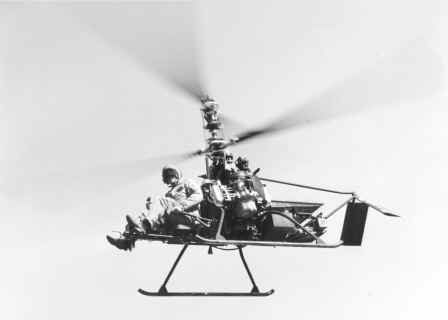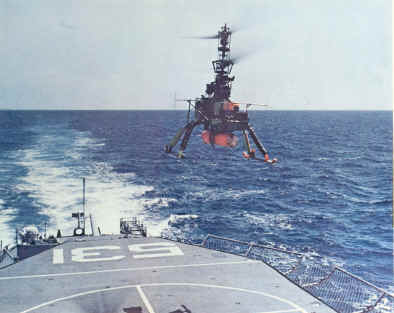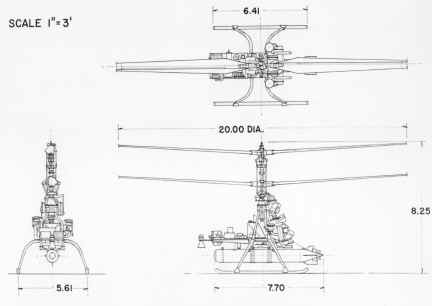
|
|
Serial Number HistoryQH-50A Drone (referred to DSN-1 prior to 1962)The following Nine Aircraft were ordered under Contract NOas 59-0219-c, BASIC |
||||
Serial Number |
Number Produced |
Acceptance Date |
DASH Program Use |
Disposition |
| DS-1000 | 1 |
March 1960 |
Tests and Demonstrations -LAD Development |
DS-1000 served the longest period- 14 months until retirement. During its term it help test the Landing Assist Device (LAD); an aid to landing helicopters on rolling pitching ship decks. While it survived, its' location is not known. |
| DS-1001 | 1 |
April 1960 |
Tests and Demonstrations |
While Flying Contractor demonstration flight at Patuxent River, MD, aircraft crashed on August 24, 1960. Aircraft had operated for 2 months. |
| DS-1002 | 1 |
May 1960 |
Tests and Demonstrations |
While Flying Contractor demonstration flight at Patuxent River, MD, aircraft crashed on September 2, 1960. Aircraft operated for 2 months. |
| DS-1003 | 1 |
June 1960 |
Tests and Demonstrations |
While Flying Contractor demonstration flights from USS HAZELWOOD (DD-531) at Key West Florida, aircraft crashed into sea on November 17, 1960. It operated for 3 months before loss. |
| DS-1004 | 1 |
September 1960 |
Tests and Demonstrations |
Used for OPTEVFOR (Operational Evaluation) for 5 months, this aircraft survived it's test program but present location is not known. |
| DS-1005 | 1 |
September 1960 | Tests and Demonstrations | This aircraft served for 10 months, and was used for AN/APN-140 (XN-1) electronic altimeter set development before being retired July 1961. Location is unknown. |
| DS-1006 | 1 | October 1960 | Technical Evaluation | Serving for 5 months until being bailed back to Gyrodyne for further study, aircraft was retired on March 1961. It was then "re-activated" under contract NOas 59-6096 for the Tilt-Float program. Current location is unknown |
| DS-1007 | 1 | November 1960 | Technical Evaluation | Having served for only 2 months, this aircraft was lost during OPTEVFOR evaluations aboard the USS HAZELWOOD (DD-531) at Key West, Florida on February 27, 1961. |
| DS-1008 | 1 | December 1960 | Technical Evaluation | While it began as a manned drone in March 1960, it was rebuilt to pure drone version by December 1960. It was later transferred on April 4, 1961 to NADC Johnsville for qualification and control systems design verification tests. Its' present location is not known. |
 In the summer of 1959, the Navy's Ships Characteristics Board decided that
aviation gasoline, a fire hazard aboard destroyers, should be removed from
destroyers that were able to carry DASH drones. Since the DSN-2 drones (seen
left with safety pilot) used gasoline powered Porsche engines, the
Chief of Naval Operations directed that the planned DSN-2 (later QH-50B
designation) production procurement for fiscal year 1960 not be made and that
the QH-50C turbine-powered drone, using the less dangerous jet fuel,
be
placed into development. Subsequently, only the original three DSN-2 aircraft were
ever produced and remain at Gyrodyne to this date, as non flyable airframes.
In the summer of 1959, the Navy's Ships Characteristics Board decided that
aviation gasoline, a fire hazard aboard destroyers, should be removed from
destroyers that were able to carry DASH drones. Since the DSN-2 drones (seen
left with safety pilot) used gasoline powered Porsche engines, the
Chief of Naval Operations directed that the planned DSN-2 (later QH-50B
designation) production procurement for fiscal year 1960 not be made and that
the QH-50C turbine-powered drone, using the less dangerous jet fuel,
be
placed into development. Subsequently, only the original three DSN-2 aircraft were
ever produced and remain at Gyrodyne to this date, as non flyable airframes.
After all DASH work was shifted from the gasoline burning QH-50A/B models and to the jet fuel burning QH-50C, the A models were eventually used as targets at Point Magu, California in 1965 for missile testing. Only 2 survive to this date and they are in private collectors hands.
![]()
PERFORMANCE SUMMARY |
|||||||
 |
 |
||||||
QH-50A Drone |
|||||||
| Take-Off Loading Conditions-ASW Attack, Full Fuel | |||||||
| QH-50A First flight of prototype on April 20, 1960 | |||||||
|
Power Plant |
Weights | ||||||
| Engine | Empty | 510 lbs | |||||
| Manufacturer | Porsche, Model YO95-6 | Normal Gross I | 900 lbs | ||||
| Type | 4 cylinder, 4 cycle, Reciprocating | Normal Gross II | 1100 lbs | ||||
|
Ratings |
Fuel and Oil | ||||||
| BHP | RPM | ALT | Fuel Tanks | One | Gallons | 9.0 gal. | |
| Military | 72 | 4500 | SL-68 degree | Grade | 100-LL | Location | Fwd- Trans |
| Normal | 72 | 4500 | SL-68 degree | Oil Spec | 30 weight | Oil Capacity | 4 quarts |
|
Ordnance |
Electronics |
||||||
| Weapons: | MK-46 single Torpedo | AN/ARW-78 - 1 set | Radio Receiving Set | ||||
| or, external payload | 300 lbs | AN/ASW-20 - 1 set | Auto Flight Control Set | ||||
Serial Number HistoryQH-50B Drone (referred to DSN-2 prior to 1962)The Three Aircraft were ordered under Contract NOas 59-0219-c, Amendment 1 |
||||
Serial Number |
Number Produced |
Acceptance Date |
DASH Program Use |
Disposition |
| N-200 | 1 |
October 1960 |
Ground Tests conducted by Gyrodyne |
N-200 was used for a 25 hr. ground test. It served for 5 months until retirement in February 1961. |
| N-201 | 1 |
November 1960 |
Flight Envelope and N-202 back-up; used by Gyrodyne |
Serving for 11 months, this manned-drone continued to expand the flight envelope to qualify the DSN-2 to DASH specifications. It was retired in October 1961 |
| N-202 | 1 |
December 1960 |
Checkout of First DSN-3 Digital control group by Gyrodyne |
Picking up where N-201 left off, N-202 was the test bed for the QH-50C's automatic flight control system including shipboard checkout of LAD up to sea state 3 |
|
All three DSN-2 aircraft were scrapped in 2002 |
||||
PERFORMANCE SUMMARY |
|||||||||||
QH-50B Drone |
|||||||||||
| Take-Off Loading Conditions-ASW Attack, Full Fuel | |||||||||||
| QH-50B First flight on September 30, 1960 | |||||||||||
|
Power Plant |
Weights | ||||||||||
| Engine | Empty | 819 lbs | |||||||||
| Manufacturer | Porsche, Model YO95-6 | Maximum Gross | 1450 lbs | ||||||||
| Type | 4 cylinder, 4 cycle, Reciprocating | Fuel (11 gallons) | 66 lbs | ||||||||
| Quantity | Two | Oil | 22 lbs | ||||||||
| Horsepower | Total 144 hp | Payload | 543 lbs | ||||||||
|
Performance |
Fuel Consumption | Fuel and Oil | |||||||||
|
Speed |
Knots | Speed | Lbs/hr. | Fuel Tanks | One | Gallons | 11.0 gal. | ||||
| Vmax at S.L. | 76.8 | at Vmax |
81.2 |
Grade | 100-LL | Location | Fwd- Trans | ||||
| V cruise | 63.0 | at cruise |
63.0 |
Oil Spec | 30 weight | Oil Capacity | 8 quarts | ||||
|
Rate of Climb |
Hovering Ceiling |
Endurance & Range |
|||||||||
| Vertical | 640 ft/min. | Out of Ground Effect | 2,950 ft. | Maximum Endurance | 1.06 hr. | ||||||
| Maximum with Forward Speed | 1,162 ft./min. | Service Ceiling | 8,600 ft. | Maximum Range | 68 n. miles | ||||||
|
Dimensions |
|||||||||||
Lengths |
Widths |
Height & Rotor |
|||||||||
| Max Length (rotors) | 20 ft. 0 inches | Width (skids) | 5 ft. 7 inches | Height (overall) | 8 ft. 3 inches | ||||||
| Length (fuselage) | 7 ft. 0 inches | Width (fuselage) | 4 ft. 6 inches | Rotor Diameter | 20 ft. 0 inches | ||||||
|
Ordnance |
|||||||||||
| Weapons: | MK-43 single Torpedo | ||||||||||
| or, external payload | 500 lbs | ||||||||||
![]()
![]()
|
The name "Gyrodyne" in its stylized
form above, is the Trademark of and owned by the Gyrodyne Helicopter Historical
Foundation; unauthorized use is PROHIBITED by Federal Law. All Photographs, technical specifications, and
content are herein copyrighted and owned exclusively by Gyrodyne Helicopter
Historical Foundation, unless otherwise stated. All Rights Reserved
©2013. |